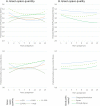Residential green space quantity and quality and symptoms of psychological distress: a 15-year longitudinal study of 3897 women in postpartum
- PMID: 30367610
- PMCID: PMC6204015
- DOI: 10.1186/s12888-018-1926-1
Residential green space quantity and quality and symptoms of psychological distress: a 15-year longitudinal study of 3897 women in postpartum
Abstract
Background: Experiments and large-scale epidemiological studies indicate the importance of green space for mental health. However, little research has been conducted to elucidate whether these mental health benefits are more dependent upon the quantity or quality of the green space.
Methods: Symptoms of psychological distress were measured in 3897 women who did not change neighbourhood up to 15 years postpartum using the Kessler 6 psychological distress scale from 2004 onwards. The percentage land-use of the neighbourhood was used to ascertain a measure of green space quantity. A Likert scale was used to measure green space quality in response to the statement "there are good parks, playgrounds and play spaces in this neighbourhood." Multilevel negative binomial growth curve regression models were used to examine the patterning of symptoms of psychological distress across the postpartum period in relation to green space quantity and quality, adjusting for person-level and geographical markers of confounding. The same variables were also fitted in multilevel logistic regressions to examine the odds of reporting serious mental illness (as defined by K6 scores ≥ 13 out of 24).
Results: Symptoms of psychological distress were fewer among women who agreed (rate ratio (RR) 0.95, 95%CI 0.91 to 0.98) and strongly agreed (RR 0.89, 95%CI 0.85 to 0.93) local parks were good quality. The odds of reporting serious mental illness were also lower among women who agreed (odds ratio (OR) 0.88, 95%CI 0.77 to 1.00) and strongly agreed (OR 0.74, 95%CI 0.64 to 0.86) local parks were good quality. No association was found between green space quantity and symptoms of psychological distress or the odds of reporting serious mental illness.
Conclusions: This study suggests it may be how mothers perceive green space nearby and what those spaces enable them to do, rather than simply how much there is overall, that is important for promoting mental health in the postpartum period. In conclusion, community consultation is likely to be a crucial part of strategies that maximise the health benefits of urban greening for everyone.
Keywords: Green space quality; Green space quantity; Mental health; Postpartum; Women.
Conflict of interest statement
Ethics approval and consent to participate
Ethics approval for this study was provided by the data custodian (The Department of Social Services of the Australian Government) and the University of Wollongong. The original consent procedure for the study for the data examined in this study involved parental responses to recruitment letters randomly selected from a sample of postcodes (response = 50.4%).
Consent for publication
Not applicable.
Competing interests
The authors declare that they have no competing interests.
Publisher’s Note
Springer Nature remains neutral with regard to jurisdictional claims in published maps and institutional affiliations.
Figures

Similar articles
-
Can green space quantity and quality help prevent postpartum weight gain? A longitudinal study.J Epidemiol Community Health. 2019 Apr;73(4):295-302. doi: 10.1136/jech-2018-211133. Epub 2019 Jan 23. J Epidemiol Community Health. 2019. PMID: 30674584 Free PMC article.
-
Association of Urban Green Space With Mental Health and General Health Among Adults in Australia.JAMA Netw Open. 2019 Jul 3;2(7):e198209. doi: 10.1001/jamanetworkopen.2019.8209. JAMA Netw Open. 2019. PMID: 31348510 Free PMC article.
-
Availability, use of, and satisfaction with green space, and children's mental wellbeing at age 4 years in a multicultural, deprived, urban area: results from the Born in Bradford cohort study.Lancet Planet Health. 2018 Jun;2(6):e244-e254. doi: 10.1016/S2542-5196(18)30119-0. Lancet Planet Health. 2018. PMID: 29880156
-
The Association between Green Space and Adolescents' Mental Well-Being: A Systematic Review.Int J Environ Res Public Health. 2020 Sep 11;17(18):6640. doi: 10.3390/ijerph17186640. Int J Environ Res Public Health. 2020. PMID: 32932996 Free PMC article.
-
Green space quantity and exposure in relation to the risk of immune-mediated diseases: a scoping review.BMC Public Health. 2024 Dec 2;24(1):3358. doi: 10.1186/s12889-024-20655-x. BMC Public Health. 2024. PMID: 39623371 Free PMC article.
Cited by
-
Mapping high-risk clusters and identifying place-based risk factors of mental health burden in pregnancy.SSM Ment Health. 2023 Dec 15;4:100270. doi: 10.1016/j.ssmmh.2023.100270. Epub 2023 Oct 6. SSM Ment Health. 2023. PMID: 38230394 Free PMC article.
-
Identifying urban built environment factors in pregnancy care and maternal mental health outcomes.BMC Pregnancy Childbirth. 2021 Sep 4;21(1):599. doi: 10.1186/s12884-021-04056-1. BMC Pregnancy Childbirth. 2021. PMID: 34481472 Free PMC article.
-
Time for 'Green' during COVID-19? Inequities in Green and Blue Space Access, Visitation and Felt Benefits.Int J Environ Res Public Health. 2021 Mar 9;18(5):2757. doi: 10.3390/ijerph18052757. Int J Environ Res Public Health. 2021. PMID: 33803166 Free PMC article.
-
The Relationship Between Green Space and Prosocial Behaviour Among Children and Adolescents: A Systematic Review.Front Psychol. 2020 Apr 30;11:859. doi: 10.3389/fpsyg.2020.00859. eCollection 2020. Front Psychol. 2020. PMID: 32425867 Free PMC article.
-
Association of greenspaces exposure with cardiometabolic risk factors: a systematic review and meta-analysis.BMC Cardiovasc Disord. 2024 Mar 20;24(1):170. doi: 10.1186/s12872-024-03830-1. BMC Cardiovasc Disord. 2024. PMID: 38509487 Free PMC article.
References
-
- Kaplan S. The restorative benefits of nature: toward an integrative framework. J Environ Psychol. 1995;15(3):169–182. doi: 10.1016/0272-4944(95)90001-2. - DOI
-
- Berto R, Baroni MR, Zainaghi A, Bettella S. An exploratory study of the effect of high and low fascination environments on attentional fatigue. J Environ Psychol. 2010;30(4):494–500. doi: 10.1016/j.jenvp.2009.12.002. - DOI
Publication types
MeSH terms
LinkOut - more resources
Full Text Sources
Medical

